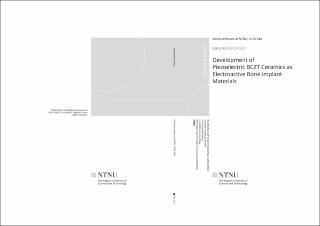| dc.contributor.advisor | Glaum, Julia | |
| dc.contributor.advisor | Einarsrud, Mari-Ann | |
| dc.contributor.author | Poon, Kara Kamen | |
| dc.date.accessioned | 2020-05-06T12:10:12Z | |
| dc.date.available | 2020-05-06T12:10:12Z | |
| dc.date.issued | 2020 | |
| dc.identifier.isbn | 978-82-326-4645-6 | |
| dc.identifier.issn | 1503-8181 | |
| dc.identifier.uri | https://hdl.handle.net/11250/2653506 | |
| dc.description.abstract | The functionalisation of current load-bearing bone implant metals with piezoelectric ceramics is envisioned as a novel opportunity for promoting tissue healing and improving the strength of the bone-implant interface through the in vivo application of power-source independent electrical cell stimulation. Calcium- and zirconium-doped barium titanate ((Ba1-xCax)(ZryTi1-y)O3 or BCZT) is a piezoelectric ceramic displaying exceptional piezoelectric responses. However, it has yet to be utilised as an implantable biomaterial and therefore, this thesis aims to assess several questions regarding its relevance to the biomedical field.
Cell responses are triggered by specific electrical stimulation requirements. As such, it is important to assess the magnitude of the piezoelectric response of BCZT and the ability to tailor the stimulation for the local physiological environment. In the first part of the thesis, good piezoelectric responses were obtained for four compositions of BCZT, influenced by the contained proportions of tetragonal, orthorhombic, and rhombohedral phases.
The implementation of BCZT as an implantable biomaterial requires an understanding of the material interactions with human cells and liquid physiological environments. The biocompatibility of BCZT was therefore assessed over a 10-day period with respect to human osteoblast and endothelial cells. Cell viability and proliferation tests showed BCZT to be not cytotoxic. In addition, an evaluation of ion release from BCZT in deionised water and sodium chloride solution over 90 days revealed an incongruent dissolution behaviour, suggesting the potential of a conditioning treatment that can be performed for safe implantation.
Physiological mechanical loads on BCZT may influence the stability of the piezoelectric response. As such, the mechanical depolarisation resistance was investigated with respect to composition and grain size by static compressive mechanical loading over a 60 min period. Both composition and grain size were observed to influence the mechanical depolarisation resistance, highlighting routes for optimising the response without toxic elemental dopants.
In the last part of the thesis, a process for integrating BCZT with existing load-bearing metal implant materials was investigated. BCZT ceramics were spray-coated onto stainless steel and Ti-alloy. Several parameters were modified with the aim of developing mechanically robust ceramic coatings. However, a highly hygroscopic region was formed during heat-treatment, affecting the stability of the ceramic coatings. It is expected that the metal/ceramic attachment and stability can be improved through the implementation of several optimised synthesis parameters.
The work in this thesis demonstrates that BCZT is promising as a relevant electrically stimulative biomaterial. It displays a good piezoelectric response that, in addition to the mechanical depolarisation resistance, can be optimised by compositional or grain size tailoring. The material is also non-cytotoxic and a feasible pre-implantation treatment has been proposed. By careful monitoring of the synthesis procedure, it is expected that a reliable metal/ceramic attachment should be achievable for the successful integration of BCZT ceramics as functional coatings on existing implant metals. | en_US |
| dc.language.iso | eng | en_US |
| dc.publisher | NTNU | en_US |
| dc.relation.ispartofseries | Doctoral theses at NTNU;2020:148 | |
| dc.relation.haspart | Poon, Kara; Wurm, Matthias C.; Evans, Donald; Einarsrud, Mari-Ann; Lutz, Rainer; Glaum, Julia. Biocompatibility of (Ba,Ca)(Zr,Ti)O3 piezoelectric ceramics for bone replacement materials. Journal of Biomedical Materials Research. Part B - Applied biomaterials 2019 s. - | en_US |
| dc.title | Development of Piezoelectric BCZT Ceramics as Electroactive Bone Implant Material | en_US |
| dc.type | Doctoral thesis | en_US |
| dc.subject.nsi | VDP::Teknologi: 500::Materialteknologi: 520 | en_US |
